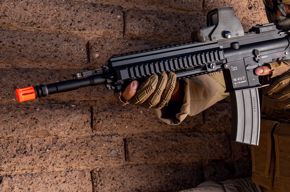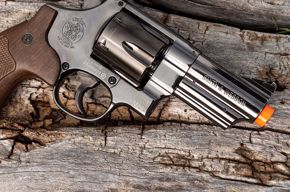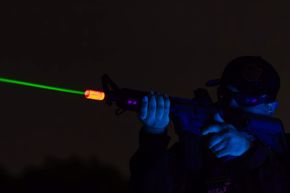Airsoft Safety
Airgun Safety Rules & Precautions
Not only do airsoft guns appear to be real, they also shoot plastic pellets. Many of the models are also fully automatic. The speed at which airsoft BBs come out of airsoft guns is much slower than the speed that BBs are shot out of a traditional BB gun. Generally speaking, this speed allows people to shoot at each other with airsoft guns safely, under certain conditions. The first condition is eyewear. Never, ever, shoot at someone who is not wearing proper eye protection. Proper eye protection means eye goggles rated at least ANSI Z87.1 or paintball goggles. Proper eye protection is not military sun/dust/wind goggles, ski goggles, or shop goggles. Do not risk your own eyes or take on liability for your friend’s eyes. Always wear proper eye protection when shooting airsoft guns! Read more about eye protection.
Also please be aware of the speeds at which all airsoft guns used in an airsoft game are shooting. Typical out-of-the-box airsoft guns shoot at ranges anywhere from 250 feet per second to 350 feet per second. Airsoft guns can be modified to shoot faster. Speeds between 375 feet per second and 400 feet per second are usually the maximum speeds US airsoft teams will allow. Make sure that anyone firing an airsoft gun over 400 feet per second is experienced, can accurately judge distance, and does not engage targets at close range. Never mix real BB guns into an airsoft gun game. If you are unsure of an airsoft gun’s firing speed either buy a chronograph to measure the speed or simply do not allow it at a game.
The simplest rule to remember with airsoft guns is to treat them as real guns. An accidental discharge at close range can have any number of damaging results including, but not limited too, broken teeth and damaged eyes.
When transporting your gun to and from a game carry it in a gun case. Not only is a gun case the safest means of transportation it also naturally protects your gun (airsoft guns can be quite fragile) and makes a great place to store airsoft pistols and spare magazines. For many areas a gun case is the only way to legally transport your airsoft gun. Remember, it is very difficult to visibly distinguish an airsoft gun from a real gun.
AIRGUNS ARE NOT TOYS. RESPONSIBLE ADULT SUPERVISION IS REQUIRED. MISUSE OR CARELESS USE MAY CAUSE SERIOUS INJURY OR DEATH.
READ THE OWNER’S OPERATION MANUAL PRIOR TO HANDLING ANY AIRGUN. PAY PARTICULAR ATTENTION TO ALL WARNINGS AND CAUTIONS. It is your duty to know and obey all laws governing the use and ownership of air guns in your city, town, province, state, and/or country.
GUN SAFETY VIDEO
Please see our safety video below for tips on how to safely own and operate any airgun that you purchase from us.
The video will only take a few minutes of your time, and lays out several of the common safety points that you may or may not have heard before when it comes to proper airgun use and ownership. A handy list of the points mentioned in the video are also included on the page so that you read along as you view it.
GUN SAFETY RULES
ALWAYS ENGAGE YOUR BRAIN BEFORE TOUCHING ANY GUN.
• Always keep the muzzle pointed in a safe direction.
• Always treat every airgun as if it were loaded.
• Always wear shooting glasses to protect your eyes.
• Always keep airguns unloaded until ready to shoot.
• Always keep a airguns “on safe” until ready to shoot.
• Always keep your finger off the trigger and out of the trigger guard until ready to shoot.
• Always be sure of your target and be sure your target has a safe backstop. Think of what you might hit if the ammunition misses or goes through your intended target. Know the danger distance of your airgun (how far the ammunition may travel).
• Always check to see if the airgun is “on safe” and unloaded when getting it from another person or from storage.
• Always read and follow all instructions, warnings, and cautions in the owner’s manual and know how your airgun works before using it.
• Always store airguns in a safe place and separate from ammunition and power source so that it cannot be used by anyone unauthorized to use it.
THINK SAFETY FIRST:
• Adult supervision is required when any type of airgun is in use.
• Never rely on an airgun’s “Safety” to protect you from unsafe handling. A safety is a mechanical device, not a substitute for common sense and good safety procedures.
• Always place the backstop in a location that will be safe should the backstop fail. Think about what may be hit if the pellet or BB misses the backstop.
• Discontinue the use of a backstop if the projectile rebounds or ricochets.
• Do not shoot at hard surfaces or the surface of water, a ricochet may occur.
• Shoot only the correct caliber and type of ammunition your airgun was designed to shoot. Check the manual to be certain.
• Do not attempt to reuse fired, damaged, or deformed pellets or BBs as they may lodge in the barrel.
• If an airgun is dropped, check to see that it works properly before using it again. If anything seems changed, like a shorter or weaker trigger pull, this may mean worn out or broken parts. Contact Umarex USA for assistance.
• Do not consume alcohol prior to, or during a shooting session.
• On air rifles, scopes are to be mounted with 2 ¾” to 3″ of eye relief to prevent bodily injury.
• On break-barrel air rifles, DO NOT PULL THE TRIGGER WITH THE BARREL BROKEN OVER. The barrel will fly up causing a bent barrel and could result in serious injury to a person.
• Perform regular maintenance on your airgun to make sure that it remains safe for use.
PRIMARY SAFETY RULES
These are the five primary rules of gun safety taught by most instructors.
1. All guns are always loaded.
- Probably more people who have been shot unintentionally were shot with “unloaded” guns than with any other kind.
2. Don’t let the muzzle of the gun cross anything you’re not prepared to shoot.
- At conventional handgun ranges, if your gun isn’t pointed at a person or object, you can’t shoot that person or object.
- Keep in mind that if the gun is pointed at an upward angle and it discharges, the bullet may travel a very long distance and strike a person or object you may not even see.
- Similarly, many walls may not stop ammunition, so rounds fired at walls may penetrate and strike a person or object on the other side.
3. Keep your finger out of the trigger guard, up on the frame of the gun, until the sights are on target and you’re prepared to shoot.
- Tradition places this rule as rule three; if I were starting fresh, I think I’d make it rule one.
- Guns do not discharge on their own. If, in the heat of battle or in total brain fade, you inadvertently point a gun at someone you don’t intend to shoot, they can’t get shot if your finger is not inside the trigger guard.
- Most guns are designed to be fired by a finger on a trigger. They are more natural to grasp that way, so the finger tends to drift there under stress. While a single-action pistol would seem more vulnerable to rule three violations, American police officers racked up countless unintended discharges in decades of using double-action revolvers, so it is essential to follow rule three regardless of the type of gun you’re handling.
4. Always be sure of your target and what’s beyond it.
- The first part of this rule is absolute: you must always identify your target.
- The second part of this rule is relative: in a sporting or training environment there is no justification for not knowing what is beyond your target. In a deadly encounter you may be forced to fire in circumstances where you may not even be able to see what is beyond your target. All the more reason to select ammunition which is not likely to exit its original target.
5. Maintain control of your gun.
- Attorneys Michael Anthony and Robert Brown have researched civil litigation involving guns and found that most successful lawsuits against gun owners involve incidents where someone other than the owner has accessed and misused the gun.
- As a result, we have accepted their suggestion and now list this fifth basic rule of firearms safety.
- Make sure that you keep the gun within your control when you carry it. Guns in purses and other means of off-body carry are difficult to control, as are guns being shown to friends, stashed between couch cushions, placed in desk drawers, etc.
- When you must store a gun that you are not carrying, take reasonable steps to limit access by unauthorized users. If you must simply disable it with a lock, a cable lock is preferable to a trigger lock – most trigger locks violate Rule Three.
- A caveat to this rule concerns dropped guns. Modern handguns are designed not to fire when dropped and people have shot themselves trying to catch guns that have slipped from their hands. If you do momentarily lose control of a gun, let it fall to the ground.
Because we do actually unload guns and also place them out of our immediate control from time to time, a corollary of Rule One and Rule Five, the condition check, is also worth learning:
Whenever you pick up a gun that has been out of your control, even if only for an instant, open the action to determine that it is in the condition in which you want it, loaded or unloaded.
A “click” when you expect a “bang!” can be as deadly as a “bang!” when you expect a “click.”



















